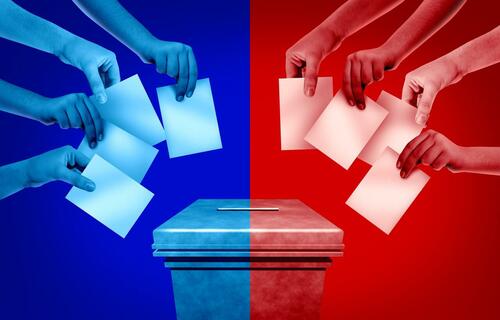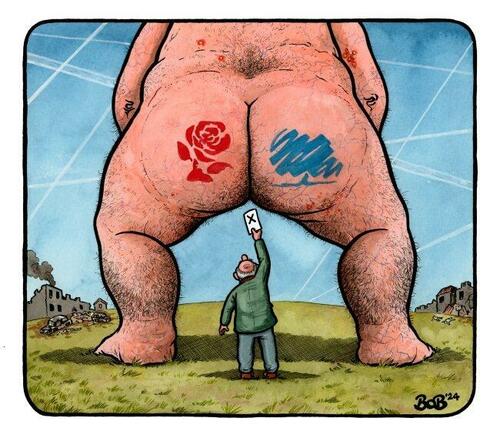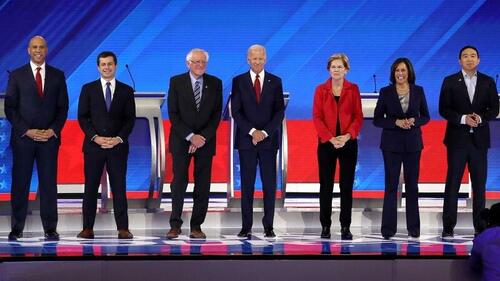How To… Rig Your Rigged Elections
Authored by Kit Knightly via Off-Guardian.org,
Are you an aspiring oligarch, dictator or autocrat? Do you want to wield power whilst maintaining a façade of popular support and democratic mandate? Do you want to make your proles believe they have a choice?
Well then, welcome to the first of our “How to…” series.
A selection of articles dedicated to teaching aspiring authoritarians how to hide tyranny behind a reassuring mask of freedom.
Here we’ll go into the finer points of how it’s possible to have “elections” that mean almost nothing.
What we talk about when we talk about rigging an election
First things first, we need to establish what we mean when we talk about “election rigging”.
Controlling the outcome of an election is a comparatively simple, even vulgar, process. All you need to do is manipulate the count and/or simply lie about the result.
However doing this efficiently – rigging an election with as little effort as possible and disguising that fact is more difficult.
In short, if your rigged election is entirely reliant on simply forging ballots you have done something wrong. If you want to reliably and consistently control the results of your “elections” you need to be more creative than that.
The vast majority of your work pre-election will be dedicated to laying the groundwork, building infrastructure, and lubricating the public.
The vote itself is the final destination in a long journey that starts with…
1. The System
The CIA is a perfect example of the kind of institution which is not answerable to the electorate. You’ll need to create your own version of this.
“If voting changed anything, they’d make it illegal.”
Your first priority when constructing your system should be establishing an infrastructure that is not significantly impacted by elections.
Unelected civil servants, intelligence agencies, military officers, judges, NGOs, corporate interests and lobby groups should form the permanent foundations of the power structure, while “elected officials” should ideally be mere window dressing and wall-paper, with zero opportunity to act independently.
Having by this means established a covert power structure that effectively guarantees an election will never be able to change anything meaningful – what we can call your “Deep State” – you need to set about creating a “democracy” that camouflages this fact.
The design of your “democracy” can make or break an efficiently controlled election. Following our advice on the voting system you employ can make controlling the outcome of your “elections” relatively hassle-free.
For starters, you should be aiming to make as little work for your Deep State as possible. A country is a big and complex entity, and effectively micro-managing millions upon millions of individual votes is demanding of man-hours and man-power.
That’s where your “voting system” comes into play, and it should work, not by falsifying and manipulating every single vote, but by making the vast majority of those votes mutually-canceling.
Using your fully controlled “two-party system” (point 2), you should try to achieve a status quo in which the voting intentions of the majority will always split fairly evenly between two meaningless “choices”.
You can do this with class or race or gender messaging, it doesn’t matter, just so long as their minds are made up at an early stage and tend to stay that way.
Essentially you need a situation in which roughly 49% of your populace will vote for Team Red and 49% will vote for Team Blue.
This then creates your mythical “election deciders” – the remaining 2% of the electorate whose votes you will need to care about. You can call them “swing states” or “floating voters” or some terminology of your own.
What you’re aiming for by this means is an “election” that is decided by as few votes as possible.
Once you have the system in place you need to start thinking about your political parties.
2. The Parties
“There is nothing which I dread so much as a division of the republic into two great parties.”
An essential part of your control mechanism is, as referenced above, the “Two-Party System”. Ideally this would be a perfect but meaningless binary, but this method can absorb a few token “third party” options provided they remain purely minority choices.
In fact permitting a few “independents” or “wild cards” to proliferate can even be beneficial for a few reasons –
a) it reinforces your appearance of genuine democracy, while remaining largely meaningless since the aforementioned entrenchment means they will never gain any serious traction.
b) because sandwiching your Big Two parties between the “kill the rich and eat their babies” party on the Left and the “set fire to everyone darker than taupe on the Dulux paint scale” party on the Right only makes your two “REAL” parties look more sensible and “safe”.
c) Hopeless minority third parties can act as good anger-sponges and safety-valves for people who may be beginning to see through your rigged system.
Of course, if you are doing this thoroughly you will probably be controlling the third parties as well. But that isn’t essential and in the main, you’ll want to focus on The Big Two.
Establishing your Big Two is relatively easy, after all, you have money and power and (thanks to your candidate filtering processes, point 3) you have an entire political class dedicated to the pursuit of those things.
Bringing both Big Two parties under your banner is easy. The hard part is refining the skill of taking two near-identical things and somehow making them appear not just different but diametrically opposed.
Your press will play an important role here. They must report only on the minor points of difference, and completely ignore or elide the obvious fact that the two parties agree on every single major issue.
IMPORTANT – The unquestioned assumptions holding your system in place only work if they remain unquestioned, and they only remain unquestioned if people don’t realise they are there.
This is the primary purpose of the Big Two parties, limit choice and control public discourse – while appearing to do the exact opposite.
When the press discuss the Big Two parties they should talk about ill-defined concepts instead of facts. Use words like “progressive”, “liberal”, “traditional” and “common sense”. Words with relative qualitative meaning as opposed to objective quantitative value.
Focus on aesthetic, surface-level differences. Contrast colours and iconography. Make sure they aim at different bases and demographics to encourage that 50/50 entrenchment we discussed in point 1.
Sidenote: One of the additional benefits of these two near-identical parties that constantly pretend to be polar opposites is that when you really need to sell something to everyone you can unite the parties in “bi-partisan support”, and the press can sell the issue as “so important that even Red and Blue agree”.
3. The Candidates
“If you own everyone on the ballot, you don’t have to rig anything.”
So, you have a power structure in place that works independently of any and all “elected” officials, you have a voting system that is easy to sway in either direction, and you have two parties as near-identical as makes no difference.
But you still need actual – for want of a better word – “people”, to fill the role of “leader”. These are your candidates, the pool of potential puppets from which you pick.
The good news here is that this process is partly automated via self-selection. The kind of shallow narcissists who seek positions of power are exactly the kinds of people you want on your roster.
It is essential for the maintenance of the status quo that ANY candidates for high political office must be passed through levels of filtration before any ordinary person has the opportunity to put a check next to their name on a ballot paper.
a) Money. Your system needs to ensure no one can run for high office without a LOT of money behind them. Since you and your class allies control all the money worth controlling, this essentially means no one can run for office without your approval.
b) Education and training. As part of your power structure you should have invested resources in your education system. You should be selecting potential “leaders” at an early stage and directing their development through internships and “excellence programs” etc.
As people progress through this system, you need to offer them opportunities to compromise themselves – morally and financially. Anyone who does not avail themselves of those opportunities must be rejected immediately and their career stalled or curtailed.
Only those candidates willing to compromise themselves will progress to the next level.
This both de-selects inappropriate applicants and provides important kompromat for future utility. Your intelligence agencies should maintain up to date dossiers on prospective candidates. Records used for what might be vulgarly described as “bribery” and/or “blackmail”.
We prefer the term “carrot and stick”.
4. The Press
It’s nearly election day. The longterm planning is done. You have a political system immune to change, a voting system where most votes are irrelevant, near identical political parties advocating your selected agenda in slightly different words, and a shortlist of candidates who you handpicked and can easily control with carrots or sticks.
But, when the actual voting is about to happen, all of that is of secondary importance to the press.
A cooperative press is one of the fundamental pillars of your political system (point 1), and we won’t be going into creating that here, that’s another lesson for another time.
For the sake of this lesson, we’ll be assuming your “Deep State” assets own and operate the vast majority of mainstream social media, print media, and audio-visual media outlets.
At that point, The Press is your first and best tool for effectively disguising the nature of your “democracy”.
Your press will tell the story of the election, and an efficiently controlled election is nothing but a story. A candidate only says what the press say he says. A candidate only does what the press say she does. Intrigues, scandals, highs-and-lows are the meat and lifeblood that make this show feel “relevant” – a wave of “incident” painting a picture of a dynamic fluid situation with an uncertain outcome, even as it steadily steers the result in your chosen direction.
Remember this isn’t about convincing people how to vote – the locked-in two-party system already renders that self-canceling and meaningless in all but those vital “swing states” (or whatever your chosen terminology). This is simply about making people pay attention, care about the outcome, feel as if vital life-changing choices are at stake, and that you are invested in those choices.
Further, this is a type of propaganda that needs to exist on the meta-level to maintain the facade of choice. The very act of attempted persuasion reinforces the idea that people need to be persuaded and, as such, that their votes matter.
This is the most vital task of your captive press – not controlling the result, but making your chosen result believable.
If you want a landslide polls can predict a landslide, if you want it to be close polls can predict it will be close. By making your carefully curated future what people expect to happen they will be more accepting of it when it happens.
Sidenote: Control of the press was simpler for the generations that came before. Unfortunately, while some aspects of your job have been made easier by technology, some others have been made far more difficult. The modern tyrant must concern themselves with the independent media, but that’s another article in this series.
5. The Votes
“Those who vote decide nothing. Those who count the vote decide everything.”
You might be wondering, if you control both sides of the election, handpick the candidates, puppeteer the press and have a system in place which means your interests are on both tickets and can literally never lose, do you need to actually rig the votes?
Well, of course you do.
While all your candidates are under your control and promoting the same basic agenda, you will still have a preferred story you want to tell at any given time and a puppet best suited to promoting that story.
For example, you might have a future psy-op planned which only works if Team Red is at the helm.
Or it might be that there is a lot of ill-feeling in the populace that you want to either a) focus on a new hate figure or b) dissipate with an apparent regime change.
It might be you owe some favours to a powerful ally and getting their relative/spouse/son into office is a pay-off.
It might be that you’ve realised, too late, your chosen puppet is so mentally unbalanced he/she might become essentially uncontrollable through your usual methods, and a last minute switch is needed.
These are circumstances where actual vote rigging becomes essential.
Thankfully, as we discussed in point one, you’ve designed a system where an election with millions of votes can be decided by a few thousand, and you have a press that will always obediently lay the groundwork by “predicting” your planned result, however improbable it might seem and even if it requires a last minute change of direction that defies all reason and sense.
You also have “tame” political parties you can unite in bi-partisan acceptance of the result and you have candidates who will always do what they are told, which makes concealing the rigging relatively easy.
So – how do we do the actual rigging?
Surprisingly, in our experience, the traditional in-person hand-written ballots are actually the hardest to manipulate, especially when there is infrastructure in place to confirm IDs and count quickly and efficiently.
This method should therefore be discouraged.
Have your captive Press refer to it as “old-fashioned” and “outdated”. Claim it benefits one side or is “racist”. The specifics don’t matter.
At the same time, you need to be promoting more “modern”, “efficient” and “fairer” methods of voting – postal voting, drop boxes, electronic voting machines and online voting.
All these methods allow for extra votes to be added quite easily via mail fraud or algorithm, or taken away via “lost ballots” or “technical glitches”. They put space – real or metaphorical – between the voter and the people who count the votes.
You can slide into that space and get to work.
And since your system means only a few thousand votes in a relatively small area will likely decide the election you don’t need to go too crazy.
Just a thumb on the scales and you get the result you want.
No one will notice – unless you happen to encounter a situation where your chosen puppet proves to be vastly more unpopular than you anticipated.
This may require last-minute “adjustments” overt enough to raise some comment. However, just make sure your tame press dismiss all such comment as “conspiracy theory” and there will be no significant long-term damage.
Sidenote: To finesse this even further, have the press report on some “glitches” and “lost ballots”. Create a background white noise of chaos but ensure BOTH SIDES are seen to both suffer and benefit, and underline that this is just the way huge modern elections work, and the margin wasn’t impacted. Then, after the fact, issue apologies, censure those “responsible” and promise to improve.
We call this “incompetence camouflage”.
Conclusion
Congratulations, with the completion of this guide you are now one step closer to a perfectly controlled dictatorship in the guise of a democracy.
You should have in place:
-
A system where your elected officials have very little power, and most votes don’t count.
-
Political parties that agree on everything of importance whilst constantly squabbling over matters of very little import.
-
A roster of candidates that are either morally or financially compromised and have been trained to do as they are told.
-
A captive press which will report only what you tell it to report.
-
Measures which make actually rigging the vote simple.
Remember, with all these safeguards and plans in place, it is easy to control the outcome of the election without anyone ever revealing the level of corruption.
…unless, for some reason, you want to make it obvious, perhaps to discredit democracy or start a civil war.
But that’s advanced-level narrative management, which we will cover in a future lesson.
You need to remember – Public belief is the reason we’re doing all of this. The illusion of choice is the lifeblood of your system. Once you reveal it’s fixed and voting doesn’t matter, they will stop voting and lose all investment.
From there your power base can quickly crumble.
Only aim for this if you have a better system already set up to replace it.
Tyler Durden
Mon, 11/04/2024 – 18:25






